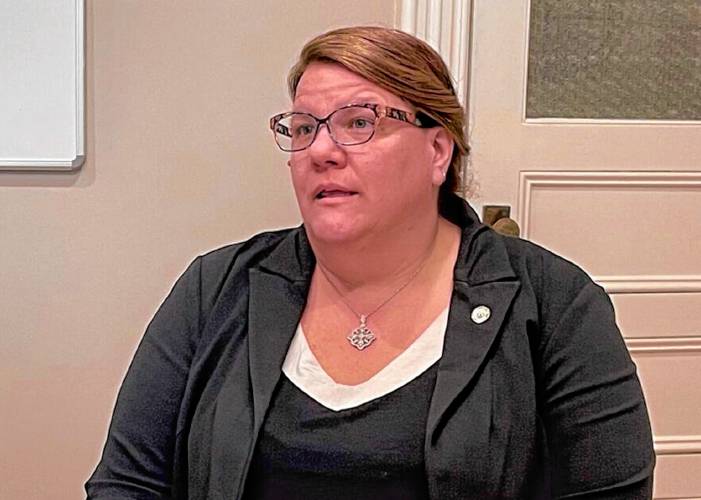Staffing shortage, high cost of overtime a concern at NH Department of Corrections

Helen Hanks, Department of Corrections commissioner. DANA WORMALD / New Hampshire Bulletin
| Published: 06-26-2024 11:56 AM |
New Hampshire’s Department of Corrections is facing a temporary $3.44 million deficit caused in large part by an increase in overtime payments, according to DOC Commissioner Helen Hanks.
Now, as the June 30 end of the state fiscal year approaches, Hanks’ department is planning to ask lawmakers to plug the $3.44 million hole by tapping into “lapsed” funds from other departments.
The expenses come as the department continues to battle staffing shortages, fueling a reliance on overtime for existing employees. Hanks says overtime usage has actually decreased in the past year, but that a new contract for corrections officers negotiated during collective bargaining has required the department to pay more for overtime hours, raising the overall cost.
Corrections officers secured a number of increased benefits last year for their 2023 to 2025 contract, after months of negotiations with the state.
State negotiators agreed to give a 10 percent raise to all staff; a 30 percent raise to nursing staff; a 5 percent to 35 percent raise to behavioral health staff; and a “reallocation process” that moved employees up into higher salary brackets. Overtime increased as well: Under the agreement, uniformed staff members now receive double overtime pay after 80 hours of work in a week, as do any staff members working on Thanksgiving, Christmas and New Year’s Day.
But while the Department of Corrections has been giving out the benefits to employees – and will continue to until July 2025 – the state’s Department of Administrative Services did not allocate quite enough money to cover the cost of the additional benefits, according to Hanks.
“The Department received warrants totaling $5,688,000 for the reallocation and $9,654,229 for the 10% increase,” Hanks wrote in an explanatory document to the Joint Legislative Fiscal Committee last week. “However, no additional funding has been received for the double overtime for uniform staff after 80 hours, the double time for staff working Thanksgiving, Christmas, and New Year’s Day, the 30% salary increase for all nursing staff, the salary increase for behavioral health staff, or the increase in shift differential for all staff and associated benefits for these increases.”
That shortfall of funding – in addition to expenses caused by the need to pay departing employees for unused leave time – created the $3.44 million deficit.
Article continues after...
Yesterday's Most Read Articles
Hanks wrote that the department expects to ask lawmakers in August to draw from two existing state funds to cover the deficit. Those accounts – the pay adjustment fund and the employee benefit adjustment account – are filled with excess salary and benefits money that agencies across the state haven’t spent because positions have become vacant.
The Department of Corrections currently has a 46 percent vacancy rate, a spokeswoman said Tuesday. Lawmakers in both parties have raised concerns.
“Somebody’s gotta address that,” said Sen. Lou D’Allesandro, a Manchester Democrat, addressing Hanks at the Fiscal Committee meeting last week. “Because that can’t go on, in my opinion, because the people that are working for you, they’re burning out. They gotta be burning out working all of that overtime. I think it creates a difficult environment.”
“I’m highly concerned, like Senator D’Allesandro, about overtime,” added Sen. Tim Lang, a Sanbornton Republican. “Especially forced overtime in a corrections facility where it’s going to create higher burnout rates for our COs.”
In an interview, Hanks noted that the vacancy rate is down from 51 percent since March 2023 – the month in which Gov. Chris Sununu authorized the state’s National Guard to help with staffing duties. Since then, DOC has embarked on a roadmap to both encourage recruitment and retention, Hanks said.
From January 2023 to May 2024, the department hosted 88 career fairs, 32 classroom talks, and 24 college and high school tours of the prison facilities, according to an information sheet from the department. They have deployed a $10,000 sign-on bonus for employees who stay for a full year, have built “employee wellness areas” that include gyms and break areas, have established family support groups for employees, and have brought in comfort dogs in times of high stress.
The department is also moving toward the use of per diem employees: workers who are not employed full-time but can choose to help with prison tasks on a daily basis. Officials have assembled a pool of people – many of them retired corrections officers – who are ready to work on an occasional basis and receive texts when opportunities arise, Hanks told lawmakers. The idea was inspired and informed by the department’s experience with the National Guard members last year, Hanks said.
“It creates an opportunity not to force (a full-time) officer to work in a post,” Hanks said. “We really want our certified law enforcement officers to be working in the housing units and doing that frontline work with those incarcerated.”
The $3.44 million shortfall, and its patchwork fix, are part of what some lawmakers say is a problem with budgeting: More and more of state operations are being funded using leftover funds from staffing shortages.
“We’ve been funding ourselves with lapses,” D’Allesandro said during the Fiscal Committee meeting. “We’ve been funding ourselves with appropriated but not filled positions. That’s how you get a lapse. And these 4 percent lapses can’t exist forever. They just can’t.
“In my opinion, this is one (issue) that I really worry about because of the future.”
Like all state agencies, the Department of Corrections is allocated funding for personnel costs by the Department of Administrative Services. Last year, the state budget trailer bill, House Bill 2, directed DAS to devote the money necessary to cover the reallocation of personnel within the DOC – a budgetary move that resulted in raises to all DOC employees.
In an interview, DAS Commissioner Charlie Arlinghaus said he had discussions with Hanks over how much he should appropriate, and that that number rose multiple times. But in the end, the number fell short of what was needed, he said.
In order to cover the cost of overtime, DOC will also move $6.1 million from other funds – primarily by transferring salary funds for unfilled vacancies. That request was approved by the Fiscal Committee last week, but even that reallocation left behind the $3.44 million deficit.
Unlike D’Allesandro, Arlinghaus argues the DOC’s use of the lapsed money in the pay adjustment fund and the employee benefit adjustment account to cover the deficit is appropriate. Most other departments do not draw so much out of those funds, which began the fiscal year with $5.245 million and $4.225 million, respectively, he said. But the DOC’s overtime costs are unique, and the solution is reasonable, he argued.
“I would say the system is pretty good for the rest of government, because what we do is we were able to take money that we know is going to end up being unspent” and use it for a department, he said.







 Mullet madness: Young man who died in motorcycle accident remembered at local fundraiser
Mullet madness: Young man who died in motorcycle accident remembered at local fundraiser ‘Entire paradigm has to shift’: Majority of parents express support for phone ban, but predict rocky rollout
‘Entire paradigm has to shift’: Majority of parents express support for phone ban, but predict rocky rollout New Hampshire committee seeks to prevent domestic fatalities like murder-suicide in Berlin
New Hampshire committee seeks to prevent domestic fatalities like murder-suicide in Berlin ‘A little piece of everything I like’: New Pittsfield barbershop brings more than a haircut to downtown
‘A little piece of everything I like’: New Pittsfield barbershop brings more than a haircut to downtown
